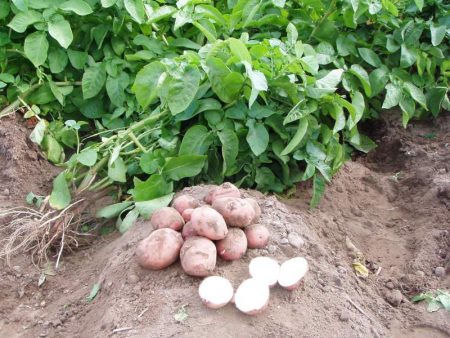 When growing potatoes, in order to get an excellent crop, you need to adhere to some tips, namely: observe crop rotation, choose disease-resistant varieties for planting, adhere to technology, increasing the immunity of plants, which in turn will give them strength in pest control and resistance to diseases. Let's see the diseases of potato: a photo, description and treatment, in order to be guided by the appearance of the plants, what kind of sore overcomes them, and urgently help green pets.
When growing potatoes, in order to get an excellent crop, you need to adhere to some tips, namely: observe crop rotation, choose disease-resistant varieties for planting, adhere to technology, increasing the immunity of plants, which in turn will give them strength in pest control and resistance to diseases. Let's see the diseases of potato: a photo, description and treatment, in order to be guided by the appearance of the plants, what kind of sore overcomes them, and urgently help green pets.
Interesting information: growing potatoes wisely without weeding and hilling.
What you need for a good harvest
- Choosing quality potatoes to plant
- The fight against virus carriers in the form of cicada, aphids, ticks)
- Timely weed and potato harvesting
- Before 3-4 years, do not return potatoes to the garden
- Isolate from cabbage, do not plant after nightshade
- Prevent tubers and soil
As for the varieties resistant to viruses, the Pamir, Rosetta, Zekura, Maidas, Lugovskaya can be attributed to them. But we must remember that young plants are most vulnerable to all kinds of sores - when they enter adulthood, the bushes grow stronger and all sorts of viruses are not so afraid of them. Early varieties of potatoes are also good because they have time to grow stronger before the mass abundance of insects, because they are less susceptible to disease, the same applies to late blight, potato bushes, like tomatoes, do not have time to get them sick. It is also necessary to clean potato tops in a timely manner in order to prevent the propagation of pests in it, and to sprout potatoes during planting, which will reduce the period of its stay in the ground, reducing the injury to tubers during harvesting and loosening of the soil, because any bacteria and viruses.
Potato late blight
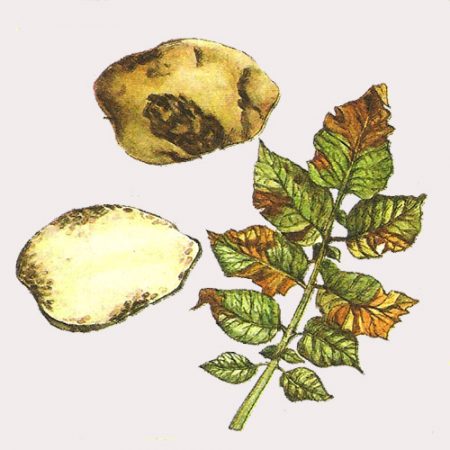
This sore is of mushroom origin and is capable of destroying up to 70% of the crop. Therefore, we observe - if during flowering brown spots on the lower leaves are noticed - we must already beware. And if in wet weather a white coating appears below the leaves - your bushes are affected by late blight, we’ll soon take action, because the name of the disease says about its properties - late blight in Greek sounds like “plant destroyer”.
Phytophthora fungus develops on the plant remains of potatoes and tomatoes, hibernates there, parasitizes on a living plant in the form of mycelium. If the tuber is infected, the fungus is quickly relocated to the stem. Depressed spots on the tuber gradually darken, stems are affected and cover the entire plantation. If the mycelium used to stay in the soil for a short time, now the infection is progressing, and can sit in the soil for several years, infecting all planted tubers.
How to treat: the use of mineral fertilizers can almost halve the likelihood of infection with late blight, and tubers must be checked by folding the infected ones, pickled with polycarbacin or nitrafen before planting. When the signs of the disease appear on the bushes for the first time, apply the Acrobat MC treatment, process it three times. You can use the drug Revus and Shirlan, effective Ditan M-45 and Bravo.
See also: Tomathouse.com for seniors.
Potato cancer
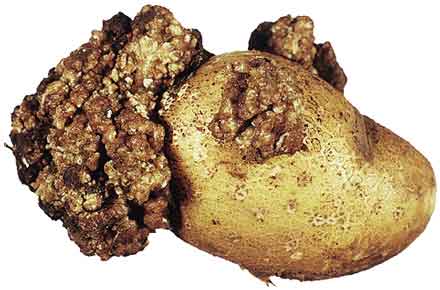
A dangerous disease that damages all parts of the potato bush in both the ground and underground parts. Bumps appear near the eyes on the potato, over time growing into large growths, the surface becomes tuberous.
How to fight: only crop rotation and the acquisition of resistant varieties can help, there is no cure.
Fomoz
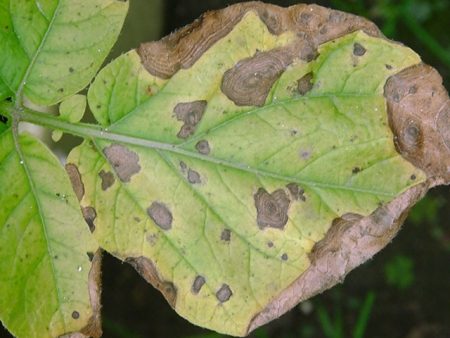
Spots form on the stems, then pycnids from them, tubers are affected by dry rot after harvesting, covered with dark spots pressed into the root crop.
For prophylaxis, it is necessary to observe the storage mode, pickle before laying for the winter, observe crop rotation and protect from injuring the tubers.
Scab of potato
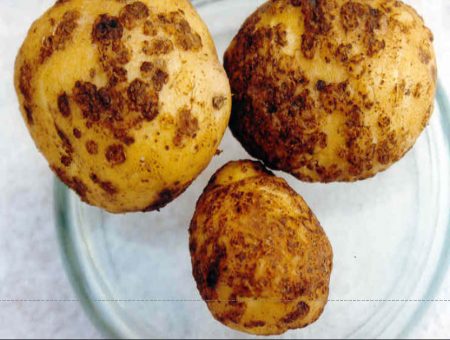
This sore can be ordinary, black, powdery or silver. The tubers lose their taste, their shelf life decreases, they become stained, sprouts can die when the mycelium penetrates the tubers from the soil.
Control measures: helps drying of tubers before laying for the winter, as well as processing with copper sulfate. Before planting - etching with drugs such as Kofugo or Fenofram super, observing crop rotation. From black and silver scab, the drug Quadris is effective.
Fusarium wilt
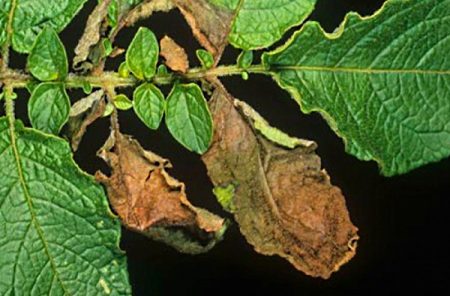
When there is intense heat and at the same time moisture evaporates intensively - the most riot for this disease, also called dry rot, which can affect up to 40% of the crop and lead to death. The stems turn brown, the leaves wilt, the bushes fade, dry out, and when pulling out, the bushes are easily pulled out. The infection quickly gets to the nearest plants, is stored in the seed material, can easily winter in plant debris, and it sits quite well in the soil in winter.
Prevention measures: Before harvesting, it is advisable to mow the tops, observe crop rotation and choose healthy nodules for planting.
Alternariosis
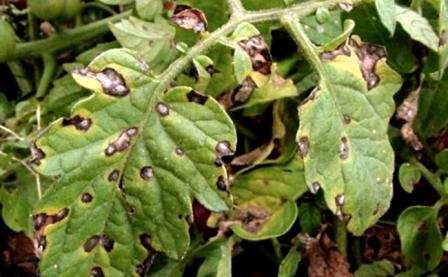
The so-called “dry spotting” affects nodules along with leaves and stems, and large brown spots appear. The stems die off, on potatoes the spots are noticeably darker than the peel, they can be wrinkled.
Control measures: Spraying by Skor, Quadrice, Shirlan, Ditan helps.
It is interesting: a garden for a bummer who does not dig up all the secrets.
Bacterial rot
If the plant withers, the leaves turn yellow and twisted - your tubers are affected by brown rot.
The same look, but when squeezing the stem, yellow mucus comes out - it is ring rot that attacked your plants. Crop rotation and sustainable potato species can make a difference.
Blackleg
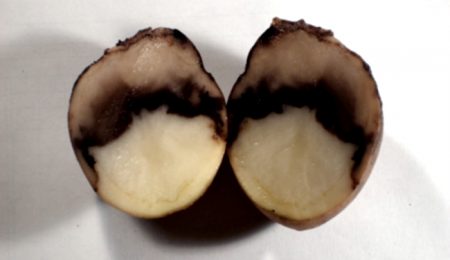
Potato is especially affected if cabbage is planted next to it. The disease is of a bacterial nature, the stems rot, the leaves turn yellow, twist, the stems come off at the root neck without effort. The tubers soften, become softer over time, and begin to emit an unpleasant odor. Crop losses of up to 76% can reach per season.
Control measures: Etching of tubers with Maxim before wintering.
Mosaic potato
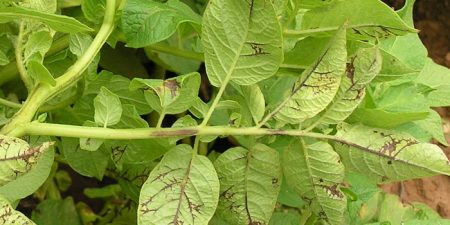
There are several types of this viral disease, all of which can damage up to 30-40% of the crop. Particularly favored by heat disease, the growing season is reduced, tubers do not develop, crop shortages occur. The leaves become wrinkled, may look corrugated, die off, and, without falling, hang on the stems.
Destroy infected bushes, observe crop rotation.
You might be interested in: tomatoes raspberry miracle reviews.




 Description and description of varieties in Belarus with a photo
Description and description of varieties in Belarus with a photo Do I need to pick flowers from potatoes: why do they do it
Do I need to pick flowers from potatoes: why do they do it When to dig potatoes: timing and availability of new potatoes
When to dig potatoes: timing and availability of new potatoes How to grow a good potato crop: various methods and methods, planting and care
How to grow a good potato crop: various methods and methods, planting and care